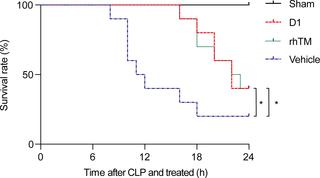Our official English website, www.x-mol.net, welcomes your feedback! (Note: you will need to create a separate account there.)
Recombinant human soluble thrombomodulin is associated with attenuation of sepsis-induced renal impairment by inhibition of extracellular histone release.
PLOS ONE ( IF 3.7 ) Pub Date : 2020-01-23 , DOI: 10.1371/journal.pone.0228093 Masayuki Akatsuka 1, 2 , Yoshiki Masuda 2 , Hiroomi Tatsumi 2 , Michiaki Yamakage 1
PLOS ONE ( IF 3.7 ) Pub Date : 2020-01-23 , DOI: 10.1371/journal.pone.0228093 Masayuki Akatsuka 1, 2 , Yoshiki Masuda 2 , Hiroomi Tatsumi 2 , Michiaki Yamakage 1
Affiliation

|
Multiple organ dysfunction induced by sepsis often involves kidney injury. Extracellular histones released in response to damage-associated molecular patterns are known to facilitate sepsis-induced organ dysfunction. Recombinant human soluble thrombomodulin (rhTM) and its lectin-like domain (D1) exert anti-inflammatory effects and neutralize damage-associated molecular patterns. However, the effects of rhTM and D1 on extracellular histone H3 levels and kidney injury remain poorly understood. Our purpose was to investigate the association between extracellular histone H3 levels and kidney injury, and to clarify the effects of rhTM and D1 on extracellular histone H3 levels, kidney injury, and survival in sepsis-induced rats. Rats in whom sepsis was induced via cecal ligation and puncture were used in this study. Histone H3 levels, histopathology of the kidneys, and the survival rate of rats at 24 h after cecal ligation and puncture were investigated. Histone H3 levels increased over time following cecal ligation and puncture. Histopathological analyses indicated that the distribution of degeneration foci among tubular epithelial cells of the kidney and levels of histone H3 increased simultaneously. Administration of rhTM and D1 significantly reduced histone H3 levels compared with that in the vehicle-treated group and improved kidney injury. The survival rates of rats in rhTM- and D1-treated groups were significantly higher than that in the vehicle-treated group. The results of this study indicated that rhTM and its D1 similarly reduce elevated histone H3 levels, thereby reducing acute kidney injury. Our findings also proposed that rhTM and D1 show potential as new treatment strategies for sepsis combined with acute kidney injury.
中文翻译:

重组人可溶性血栓调节蛋白通过抑制细胞外组蛋白的释放与败血症诱导的肾功能损害的减轻相关。
由脓毒症引起的多器官功能障碍通常涉及肾脏损伤。响应于损伤相关分子模式而释放的细胞外组蛋白促进败血症诱导的器官功能障碍。重组人可溶性血栓调节蛋白(rhTM)及其凝集素样结构域(D1)发挥抗炎作用并中和与损伤相关的分子模式。然而,rhTM和D1对细胞外组蛋白H3水平和肾脏损伤的影响仍然知之甚少。我们的目的是研究细胞外组蛋白H3水平与肾脏损伤之间的关系,并阐明rhTM和D1对败血症诱导的大鼠细胞外组蛋白H3水平,肾脏损伤和存活的影响。通过盲肠结扎和穿刺诱导败血症的大鼠用于本研究。组蛋白H3水平 研究了肾脏的组织病理学以及盲肠结扎和穿刺后24小时大鼠的存活率。盲肠结扎和穿刺后,组蛋白H3水平随时间增加。组织病理学分析表明,肾小管上皮细胞中变性灶的分布和组蛋白H3的水平同时增加。与赋形剂治疗组相比,rhTM和D1的给药显着降低了组蛋白H3水平,并改善了肾脏损伤。rhTM和D1治疗组大鼠的存活率显着高于媒介物治疗组。这项研究的结果表明,rhTM及其D1同样降低了升高的组蛋白H3水平,从而减轻了急性肾脏损伤。
更新日期:2020-01-24
中文翻译:

重组人可溶性血栓调节蛋白通过抑制细胞外组蛋白的释放与败血症诱导的肾功能损害的减轻相关。
由脓毒症引起的多器官功能障碍通常涉及肾脏损伤。响应于损伤相关分子模式而释放的细胞外组蛋白促进败血症诱导的器官功能障碍。重组人可溶性血栓调节蛋白(rhTM)及其凝集素样结构域(D1)发挥抗炎作用并中和与损伤相关的分子模式。然而,rhTM和D1对细胞外组蛋白H3水平和肾脏损伤的影响仍然知之甚少。我们的目的是研究细胞外组蛋白H3水平与肾脏损伤之间的关系,并阐明rhTM和D1对败血症诱导的大鼠细胞外组蛋白H3水平,肾脏损伤和存活的影响。通过盲肠结扎和穿刺诱导败血症的大鼠用于本研究。组蛋白H3水平 研究了肾脏的组织病理学以及盲肠结扎和穿刺后24小时大鼠的存活率。盲肠结扎和穿刺后,组蛋白H3水平随时间增加。组织病理学分析表明,肾小管上皮细胞中变性灶的分布和组蛋白H3的水平同时增加。与赋形剂治疗组相比,rhTM和D1的给药显着降低了组蛋白H3水平,并改善了肾脏损伤。rhTM和D1治疗组大鼠的存活率显着高于媒介物治疗组。这项研究的结果表明,rhTM及其D1同样降低了升高的组蛋白H3水平,从而减轻了急性肾脏损伤。


























 京公网安备 11010802027423号
京公网安备 11010802027423号